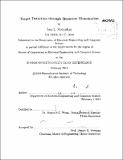| dc.contributor.advisor | Franco N.C. Wong. | en_US |
| dc.contributor.author | Mouradian, Sara L. (Sara Lambert) | en_US |
| dc.contributor.other | Massachusetts Institute of Technology. Dept. of Electrical Engineering and Computer Science. | en_US |
| dc.date.accessioned | 2013-02-14T15:39:58Z | |
| dc.date.available | 2013-02-14T15:39:58Z | |
| dc.date.copyright | 2010 | en_US |
| dc.date.issued | 2012 | en_US |
| dc.identifier.uri | http://hdl.handle.net/1721.1/77028 | |
| dc.description | Thesis (M. Eng.)--Massachusetts Institute of Technology, Dept. of Electrical Engineering and Computer Science, February 2012. | en_US |
| dc.description | "February 2012." Cataloged from PDF version of thesis. | en_US |
| dc.description | Includes bibliographical references (p. 69-70). | en_US |
| dc.description.abstract | Classical target detection can suffer large error probabilities in noisy and lossy environments when noise photons are mistaken for signal photons reflected from an object. It has been shown theoretically that the correlation between entangled photons can be used to better discriminate between the signal photons reflected by an object and noise photons, thus reducing the probability of error [13, 15, 17, 7, 6]. This thesis presents the first experimental implementation of target detection enhanced by quantum illumination (QI). Nondegenerate, time entangled signal and idler beams are created through Type-O spontaneous parametric downconversion (SPDC). The signal is attenuated and combined with large levels of noise. The signal is phase modulated to improve the observation by shifting it from DC to 16 kHz. The return signal and idler are recombined in an optical parametric amplifier (OPA) which captures the phase correlation between the two beams. It is found that only 10% of the total signal and idler photons interact at the OPA due to the multi-mode nature of the SPDC emission which does not match the pump spatial mode and thus experience lower gains at the OPA. Considering only the power interacting at the OPA, the signal-to-noise ratio (SNR) of QI agrees with the theoretical model. | en_US |
| dc.description.statementofresponsibility | by Sara L. Mouradian. | en_US |
| dc.format.extent | 70 p. | en_US |
| dc.language.iso | eng | en_US |
| dc.publisher | Massachusetts Institute of Technology | en_US |
| dc.rights | M.I.T. theses are protected by
copyright. They may be viewed from this source for any purpose, but
reproduction or distribution in any format is prohibited without written
permission. See provided URL for inquiries about permission. | en_US |
| dc.rights.uri | http://dspace.mit.edu/handle/1721.1/7582 | en_US |
| dc.subject | Electrical Engineering and Computer Science. | en_US |
| dc.title | Target detection through quantum illumination | en_US |
| dc.type | Thesis | en_US |
| dc.description.degree | M.Eng. | en_US |
| dc.contributor.department | Massachusetts Institute of Technology. Department of Electrical Engineering and Computer Science | |
| dc.identifier.oclc | 825807549 | en_US |
